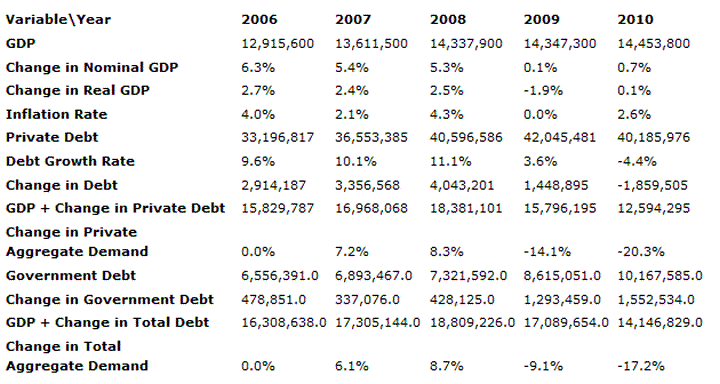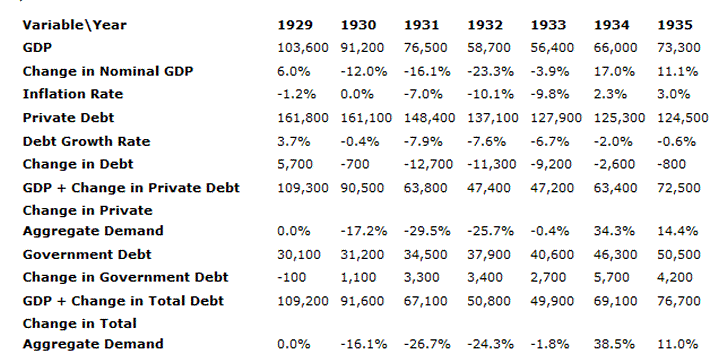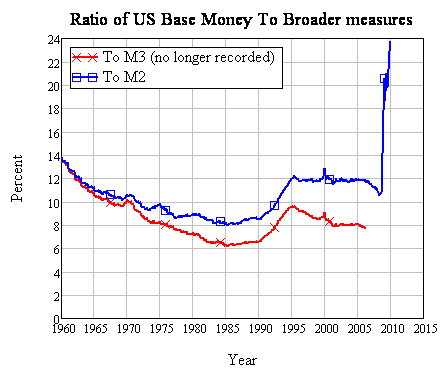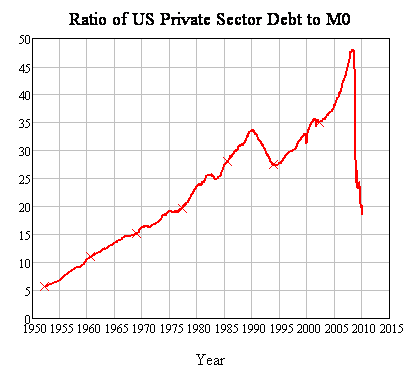What Bernanke Doesn’t Understand About Debt Deflation and the Economy, Back to the Future
Economics / Deflation Sep 07, 2010 - 04:00 AM GMTBy: John_Mauldin
 This week's Outside the Box is an incendiary blog written by Steve Keen on debt deflation and GDP growth. I am not certain as to his math (is he double counting debt and consumer spending?) but he does illustrate very well the problem of a deleveraging recession, which I have been writing about for a long time. This is just a different type of recession we are in. So rather than fret over the absolute certainty of the math, read this for an understanding of the nature of the problems we face. He has the direction right, I think, which is the important part for us to grasp.
This week's Outside the Box is an incendiary blog written by Steve Keen on debt deflation and GDP growth. I am not certain as to his math (is he double counting debt and consumer spending?) but he does illustrate very well the problem of a deleveraging recession, which I have been writing about for a long time. This is just a different type of recession we are in. So rather than fret over the absolute certainty of the math, read this for an understanding of the nature of the problems we face. He has the direction right, I think, which is the important part for us to grasp.
Then he just now posted a second blog on Quantitative Easing, which he ends with pointing out why it might "work" but also suggests that it would lead to yet another financial bubble. Again, very Outside the Box thinking. It has me going 'hmmm.'
Steve Keen is Associate Professor of Economics & Finance at the University of Western Sydney, and author of the popular book Debunking Economics. He has won numerous awards and is widely published in academia. Seems quite the serious guy. You can read his material at http://www.debtdeflation.com/blogs/.
Your working on Labor Day analyst,
John Mauldin, Editor Outside the Box
What Bernanke Doesn't Understand
By Steve Keen
Bernanke's recent Jackson Hole speech didn't contain one reference to the key force driving the American economy right now: private sector deleveraging (here's the previous year's speech for comparison's sake). The reason the US economy is not recovering from this crisis is because all sectors of American society took on too much debt during the false boom of the last two decades, and they are now busily getting themselves out of debt any way they can.
Debt reduction is now the real story of the American economy, just as real story behind the apparent free lunch of the last two decades was rising debt. The secret that has completely eluded Bernanke is that aggregate demand is the sum of GDP plus the change in debt. So when debt is rising demand exceeds what it could be on the basis of earned incomes alone, and when debt is falling the opposite happens.
I've been banging the drum on this for years now, but it's a hard idea to communicate because it's so alien to the way most economists (and many people) think. For a start, it involves a redefinition of aggregate demand. Most economists are conditioned to think of commodity markets and asset markets as two separate spheres, but my definition lumps them together: aggregate demand is the sum of expenditure on goods and services, PLUS the net amount of money spent buying assets (shares and property) on the secondary markets. This expenditure is financed by the sum of what we earn from productive activities (largely wages and profits) PLUS the change in our debt levels. So total demand in the economy is the sum of GDP plus the change in debt.
I've recently developed a simple numerical example that makes this case easier to understand: imagine an economy with a nominal GDP of $1,000 billion which is growing at 10 percent a year, due to an inflation rate of 5 percent and a real growth rate of 5 percent, and in which private debt is $1,250 billion and is growing at 20% a year.
Aggregate private sector demand in this economy -- expenditure on all markets, including asset markets -- is therefore $1,250 billion: $1,000 billion from expenditure from income (GDP) and $250 billion from the change in debt. At the end of the year, private debt will be $1,500 billion. Expenditure is thus 20 percent above the level that could be financed by income alone.
Now imagine that the following year, the rate of growth of GDP continues at 10 percent, but the rate of growth of debt slows from 20 to 10 percent. GDP will have grown to $1,100 billion, while the increase in private debt this year will be $150 billion -- 10 percent of the initial $1,500 billion total and therefore $100 billion less than the $250 billion increase the year before.
Aggregate private sector demand in this economy will therefore be $1,250 billion, consisting of $1,100 billion from GDP and $150 billion from rising debt -- exactly the same as the year before. But since inflation has been running at 5 percent, aggregate demand will be 5 percent lower than the year before in real terms. So simply stabilising the debt to GDP ratio results in a fall in demand in real terms, and some markets -- commodities and/or assets -- must take a hit.
Putting this example in a table, we get the following illustration:
| Variable/Year | Year 1 | Year 2 |
| Nominal GDP | 1000 | 1100 |
| Growth rate of Nominal GDP | 10% | 10% |
| Real growth rate | 5% | 5% |
| Inflation Rate | 5% | 5% |
| Private Debt | 1250 | 1500 |
| Growth rate of Private Debt | 20% | 10% |
| Change in Private Debt | 250 | 150 |
| Nominal Aggregate demand (GDP + Change in Debt) | 1250 | 1250 |
Notice that nominal aggregate demand remains constant across the two years - but this means that real output has to fall, since half of the recorded growth in nominal GDP is inflation. So even stabilising the debt to GDP ratio causes a fall in real aggregate demand. Some markets - whether they're for goods and services or assets like shares and property - have to take a hit.
Now let's apply this to the US economy for the last few years, in somewhat more detail. There are some rough edges to the following table -- the year to year changes put some figures out of whack, and some change in debt is simply compounding of unpaid interest that doesn't add to aggregate demand -- but in the spirit of "I'd rather be roughly right than precisely wrong", at your leisure please work your way through the table below.
Its key point can be grasped just by considering the GDP and the change in debt for the two years 2008 and 2010: in 2007-2008, GDP was $14.3 trillion while the change in private sector debt was $4 trillion, so aggregate private sector demand was $18.3 trillion. In calendar year 2009-10, GDP was $14.5 trillion, but the change in debt was minus $1.9 trillion, so that aggregate private sector demand was $12.6 trillion. The turnaround in two years in the change of debt has literally sucked almost $6 trillion out of the US economy.

That sucking sound will continue for many years, because the level of debt that was racked up under Bernanke's watch, and that of his predecessor Alan Greenspan, was truly enormous. In the years from 1987, when Greenspan first rescued the financial system from its own follies, till 2009 when the US hit Peak Debt, the US private sector added $34 trillion in debt. Over the same period, the USA's nominal GDP grew by a mere $9 trillion.
Ignoring this growth in debt -- championing it even in the belief that the financial sector was being clever when in fact it was running a disguised Ponzi Scheme -- was the greatest failing of the Federal Reserve and its many counterparts around the world.
Though this might beggar belief, there is nothing sinister in Bernanke's failure to realize this: it's a failing that he shares in common with the vast majority of economists. His problem is the theory he learnt in high school and university that he thought was simply "economics" -- as if it was the only way one could think about how the economy operated. In reality, it was "Neoclassical economics", which is just one of the many schools of thought within economics. In the same way that Christianity is not the only religion in the world, there are other schools of thought in economics. And just as different religions have different beliefs, so too do schools of thought within economics -- only economists tend to call their beliefs "assumptions" because this sounds more scientific than "beliefs".
Let's call a spade a spade: two of the key beliefs of the Neoclassical school of thought are now coming to haunt Bernanke -- because they are false. These are that the economy is (almost) always in equilibrium, and that private debt doesn't matter.
One of Bernanke's predecessors who also once believed these two things was Irving Fisher, and just like Bernanke, he was originally utterly flummoxed when the US economy collapsed from prosperity to Depression back in 1930. But ultimately he came around to a different way of thinking that he christened "The Debt Deflation Theory of Great Depressions" (Fisher 1933).
You would think Bernanke, as the alleged expert on the Great Depression -- after all, that's one of the main reasons he got the job as Chairman of the Federal Reserve -- had read Fisher's papers. And you'd be right. But the problem is that he didn't understand them -- and here we come back to the belief problem. The Great Depression forced Fisher -- who was also a Neoclassical economist -- to realize that the belief that the economy was always in equilibrium was false. When Bernanke read Fisher, he completely failed to grasp this point. Just as a religious scholar from, for example, the Hindu tradition might completely miss the key points in the Christian Bible, Bernanke didn't even register how important abandoning the belief in equilibrium was to Fisher.
To know this, all you have to do is read Bernanke's summary of Fisher in his Essays on the Great Depression:
The idea of debt-deflation goes back to Irving Fisher (1933). Fisher envisioned a dynamic process in which falling asset and commodity prices created pressure on nominal debtors, forcing them into distress sales of assets, which in turn led to further price declines and financial difficulties. His diagnosis led him to urge President Roosevelt to subordinate exchange-rate considerations to the need for reflation, advice that (ultimately) FDR followed.
Fisher's idea was less influential in academic circles, though, because of the counterargument that debt-deflation represented no more than a redistribution from one group (debtors) to another (creditors). Absent implausibly large differences in marginal spending propensities among the groups, it was suggested, pure redistributions should have no significant macroeconomic effects." (Bernanke 2000, p. 24)
There's no mention of disequilibrium there, and though Bernanke went on to try to develop the concept of debt-deflation, he did so while maintaining the belief in equilibrium. Compare this to Fisher himself on how important disequilibrium really is in the real world:
We may tentatively assume that, ordinarily and within wide limits, all, or almost all, economic variables tend, in a general way, toward a stable equilibrium... But the exact equilibrium thus sought is seldom reached and never long maintained. New disturbances are, humanly speaking, sure to occur, so that, in actual fact, any variable is almost always above or below the ideal equilibrium...
It is as absurd to assume that, for any long period of time, the variables in the economic organization, or any part of them, will "stay put," in perfect equilibrium, as to assume that the Atlantic Ocean can ever be without a wave. (Fisher 1933, p. 339)
We might not be in such a pickle now if economics had started to become more of a science and less of a religion by following Fisher's lead, and abandoning key beliefs when reality made a mockery of them. But instead neoclassical economics completely rebuilt its belief system after the Great Depression, and here we are again, once more experiencing the disconnect between neoclassical beliefs and economic reality.
For the record, here's my "GDP plus change in debt" table for the 1930s, to give us some idea of what the next decade or so might hold if, once again, we repeat the mistakes of our predecessors.

Bernanke, B. S. (2000). Essays on the Great Depression. Princeton, Princeton University Press. Fisher, I. (1933). "The Debt-Deflation Theory of Great Depressions." Econometrica 1(4): 337-357. Click here to download this post as a PDF file.
Back to the Future - (The second post)
Things are looking grim indeed for the US economy. Unemployment is out of control -- especially if you consider the U-6 (16.7%, up 0.2% in the last month) and Shadowstats (22%, up 0.3%) measures, which are far more realistic than the effectively public relations U-3 number that passes for the "official" unemployment rate (9.6%, up 0.1%).
The US is in a Depression, and the sooner it acknowledges that -- rather than continuing to pretend otherwise -- the better. Government action has attenuated the rate of decline, but not reversed it: a huge fiscal and monetary stimulus has put the economy in limbo rather than restarting growth, and the Fed's conventional monetary policy arsenal is all but depleted.
This prompted MIT professor of economics Ricardo Cabellero to suggest a more radical approach to monetary easing, in a piece re-published last Wednesday in Business Spectator (reproduced from Vox). Conventional "Quantitative Easing" involves the Treasury selling bonds to the Fed, and then using the money to fund expenditure -- so public debt increases, and it has to be serviced. We thus swap a private debt problem for a public one, and the boost to spending is reversed when the bonds are subsequently retired. Instead, Caballero proposes
a fiscal expansion (e.g. a temporary and large cut of sales taxes) that does not raise public debt in equal amount. This can be done with a "helicopter drop" targeted at the Treasury. That is, a monetary gift from the Fed to the Treasury. (Ricardo Caballero)
The government would thus spend without adding to debt, with the objective of causing inflation by having "more dollars chasing goods and services". This is preferable to the deflationary trap that has afflicted Japan for two decades, and now is increasingly likely in the US. So on the face of it, Cabellero's plan appears sound: inflation will reduce the real value of financial assets, shift wealth from older to younger generations, and stimulate both supply and demand by making it more attractive to spend and invest than to leave dollars languishing, and losing real value, in the bank.
However, though this is indeed the right time to consider radical solutions, Cabellero's proposal would do only half the required job. Focusing on the good bit, one reason we got into this predicament in the first place was because private sector, debt-based money swamped public sector, fiat money. Ultimately we need to return to the public-private money balance we had in the 1950s and early 1960s.
But if getting "Back to the Future" was all we needed to do, then our problems would already be over, because Ben's Helicopter Drop of late 2008 has got us there already: the ratio of M0 to M2 is now almost 0.25, far higher than the 1960 level of 0.14, while the ratio to M3 is back where it was then (using Shadowstats data, which I can't publish here since it's proprietary).

So why aren't we "Back To The Future" already? Why isn't the economy booming once more, and why is inflation giving way to deflation?
Because, though the money supply is back to where it was in 1960, the debt to money ratio is utterly different. Even after Ben's Helicopter Drop, the debt to base money ratio is almost twice what it was in 1960, and over 3 times what it was back in the Golden Days of the 1950s.

This points out the blind spot in the thinking of even progressive Neoclassicals like Cabellero, who are willing to consider unconventional policies: they don't understand how money is created in our credit-driven economy. Because of that, they don't appreciate how much of that credit has financed a glorified Ponzi Scheme rather than investment, nor do they comprehend the impact that private sector deleveraging is having on aggregate demand.
I've covered the first topic ad nauseam in my post " The Roving Cavaliers of Credit", so I won't repeat myself here. Instead I'll focus on the obvious message from the above chart: if the government simply pumps its money into the system without restraining the financial system from financing speculation on asset markets, the best we can hope for is a repeat of this crisis, on an even larger scale, some years down the track. To see that, all we have to do is look at what happened back in the 1980s.
The Debt to M0 ratio, which had risen sixfold since the 1950s, went into sudden reverse as the economy imploded when the Savings and Loans fiasco ended. The growth of debt collapsed, and the State tried to rescue the financial sector from its follies by fiscal policy and boosting the money supply. That rescue ultimately succeeded when the recession of the 1990s finally ended, but since finance was emboldened rather than reformed, it simply financed two further fiascos: the DotCom madness and then the Subprime scam.
The reason why the 1990s rescue isn't working this time stands out more clearly when you look at the changes in debt and M0 in raw dollar terms (the scale of the change in M0 is 1/5th that for the change in debt in next two graphs). In the 1990s crisis, the rate of growth of private debt slowed by 2/3rds, but it didn't actually fall; and a quadrupling of the rate of growth of M0 (starting half a year after debt growth slowed down) was enough, after several years, to let the Wall Street party resume.

This time, the change in debt has turned solidly negative -- having growth at up to $4 trillion p.a., it is now shrinking at over $2 trillion. Ben's far larger quantitative easing (when compared to Alan's back in 1990-94) simply hasn't been enough to fight a private sector that is now seriously deleveraging.

QE2 could nonetheless work, if Cabellero's plan was executed with gusto. But if all we do is effect a monetary rescue, and yet leave the finance sector untouched, then it will reborn once again as an even bigger Ponzi Scheme.
Do we really want to go through all that again?
I'll explain two truly major financial reforms that could prevent another credit and asset bubble in a subsequent piece.
John F. Mauldinjohnmauldin@investorsinsight.com
John Mauldin, Best-Selling author and recognized financial expert, is also editor of the free Thoughts From the Frontline that goes to over 1 million readers each week. For more information on John or his FREE weekly economic letter go to: http://www.frontlinethoughts.com/learnmore
To subscribe to John Mauldin's E-Letter please click here:http://www.frontlinethoughts.com/subscribe.asp
Copyright 2010 John Mauldin. All Rights Reserved
Note: John Mauldin is the President of Millennium Wave Advisors, LLC (MWA), which is an investment advisory firm registered with multiple states. John Mauldin is a registered representative of Millennium Wave Securities, LLC, (MWS), an FINRA registered broker-dealer. MWS is also a Commodity Pool Operator (CPO) and a Commodity Trading Advisor (CTA) registered with the CFTC, as well as an Introducing Broker (IB). Millennium Wave Investments is a dba of MWA LLC and MWS LLC. Millennium Wave Investments cooperates in the consulting on and marketing of private investment offerings with other independent firms such as Altegris Investments; Absolute Return Partners, LLP; Plexus Asset Management; Fynn Capital; and Nicola Wealth Management. Funds recommended by Mauldin may pay a portion of their fees to these independent firms, who will share 1/3 of those fees with MWS and thus with Mauldin. Any views expressed herein are provided for information purposes only and should not be construed in any way as an offer, an endorsement, or inducement to invest with any CTA, fund, or program mentioned here or elsewhere. Before seeking any advisor's services or making an investment in a fund, investors must read and examine thoroughly the respective disclosure document or offering memorandum. Since these firms and Mauldin receive fees from the funds they recommend/market, they only recommend/market products with which they have been able to negotiate fee arrangements.
Opinions expressed in these reports may change without prior notice. John Mauldin and/or the staffs at Millennium Wave Advisors, LLC and InvestorsInsight Publishing, Inc. ("InvestorsInsight") may or may not have investments in any funds cited above.
Disclaimer PAST RESULTS ARE NOT INDICATIVE OF FUTURE RESULTS. THERE IS RISK OF LOSS AS WELL AS THE OPPORTUNITY FOR GAIN WHEN INVESTING IN MANAGED FUNDS. WHEN CONSIDERING ALTERNATIVE INVESTMENTS, INCLUDING HEDGE FUNDS, YOU SHOULD CONSIDER VARIOUS RISKS INCLUDING THE FACT THAT SOME PRODUCTS: OFTEN ENGAGE IN LEVERAGING AND OTHER SPECULATIVE INVESTMENT PRACTICES THAT MAY INCREASE THE RISK OF INVESTMENT LOSS, CAN BE ILLIQUID, ARE NOT REQUIRED TO PROVIDE PERIODIC PRICING OR VALUATION INFORMATION TO INVESTORS, MAY INVOLVE COMPLEX TAX STRUCTURES AND DELAYS IN DISTRIBUTING IMPORTANT TAX INFORMATION, ARE NOT SUBJECT TO THE SAME REGULATORY REQUIREMENTS AS MUTUAL FUNDS, OFTEN CHARGE HIGH FEES, AND IN MANY CASES THE UNDERLYING INVESTMENTS ARE NOT TRANSPARENT AND ARE KNOWN ONLY TO THE INVESTMENT MANAGER.
John Mauldin Archive |
© 2005-2022 http://www.MarketOracle.co.uk - The Market Oracle is a FREE Daily Financial Markets Analysis & Forecasting online publication.



